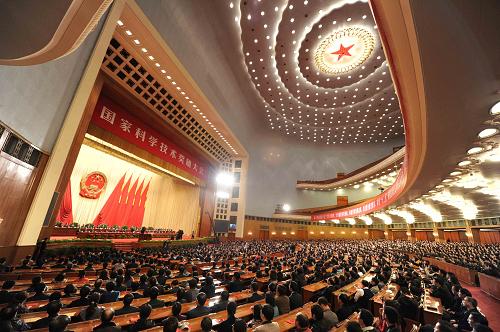
The 2010 National Science and Technology Awards Conference was held on 14 January 2011 in the Great Hall of the People in Beijing. During the Ceremony, the project of “The Lopingian Series of China and end-Permian mass extinction” accomplished by the late Academician Professor JIN Yugan, Professor SHEN Shuzhong, Professor WANG Xiangdong, Professor WANG Yue and Professor CAO Changqun from Nanjing Institute of Geology and Palaeontology Chinese Academy of Sciences was accredited the National Science and Technology Progress Awards -- Second Prize.
“The Lopingian Series of China and end-Permian mass extinction” project focused on the major bio-events and environmental backgrounds during the critical time of the geological history, representing one of the leading basic researches in earth sciences. Among five mass extinctions in the geological history, the end-Permian mass extinction represents the greatest turnover of the ecosystem on earth, during which about 95% of the marine species and 75% of the terrestrial species became extinct. The passive-feeding benthic fauna once dominated the ocean for more than 3500 Ma was replaced by the active-feeding and swimming animals, which still reign the world’s oceans today. The cause of the end-Permian mass extinction has been one of the hotest topics in geosciences and attracted much attention from the public. To understand the process and the mechanism of the event, it is essential to work on the stratigraphy and the paleontology of the time, and reveal the interaction between the biome and the environments within a global framework of the stratigraphy. JIN et al’s studies have achieved the followings:
1) Statistical analysis on the stratigraphic ranges of the fossil records from the Meishan section in Changxing, Zhejiang Province, as well as the mathematical modeling of the end-Permian mass extinction were accomplished under the constrains of the precise isotopic age, the high resolution biostratigraphy, and the chemical stratigraphy. The end-Permian mass extinction, for the first time, was proved as a sudden catastrophic event triggered by a sudden deterioration of the environments. The results represent an innovative breakthrough among the studies of the end-Permian mass extinction.
2) Based on the relatively complete and accurate fossil records, JIN et al proposed a two-phase model for the end-Permian mass extinction. The two-phase event consisted of the pre-Lopingian bioevent and the major phase of end-Permian mass extinction, with about 8 Ma separating the two phases. The basic framework of the end-Permian mass extinction was firmly established by this study.
3) JIN et al established the Global Stratotype Section and Points (GSSPs) for the base-Lopingian at the
Penglaitan section in Laibin, Guangxi Province and for the base-Changhsingian at the Meishan section in Changxing, Zhejiang Province through the systematic researches on the high-resolution biostratigraphy. The two GSSPs not only won two ‘golden spikes’ for our country, but also provide global standards for the correlations on the Late Permian.
4) JIN et al proposed a new chronostratigraphic subdivision of the Permian system with the Lopingian,
Guadalupian, and Cisuralian as the Upper, Middle, and Lower Permian respectively. This proposal was formally ratified by the International Union of Geological Science to replace the traditional two-fold division based on standard Russian localities for more than 150 years. The Chinese chronostratigraphic units, the Lopingian and its subdivisions of Wuchiapingian and Changhsingian, were for the first time listed as the standard in the international chronostratigraphic chart, thus providing a solid framework for the stratigraphic correlations of the Late Permian.
5) JIN et al conducted a synthetic research of the biostratigraphy and chemical stratigraphy from more than 10 sections in South China and Tibet. All the inorganic, organic carbon and sulfur isotopic data demonstrated that the abrupt drifts occurred in both intervals of the pre-Lopingian bioevent and the end-Permian mass extinction. Further research on the biomarkers was undertaken by a drilling project at Meishan in Changxing to explore the interactive relationship between the mass extinction and the environmental changes.
Download:
